clock BMW M3 CONVERTIBLE 2006 E46 Owner's Manual
[x] Cancel search | Manufacturer: BMW, Model Year: 2006, Model line: M3 CONVERTIBLE, Model: BMW M3 CONVERTIBLE 2006 E46Pages: 174, PDF Size: 2.68 MB
Page 9 of 174

Contents
9
Passenger safety systems:
Airbags55
Transporting children safely58
Rollover protection system62
Vehicle Memory, Key
Memory64
Driving:
Ignition lock65
Starting the engine and driving
off66
Switching off the engine68
Parking brake68
Manual transmission69
Sequential M gearbox with
Drivelogic*70
Turn signal indicator/Headlamp
flasher75
Washer/wiper system/Rain
sensor*76
Cruise control77
Everything under control:
Odometer79
Tachometer79
Engine oil temperature79
Fuel gauge80
Engine coolant temperature
gauge80
Service interval display81
Check Control81
Clock82
Computer83
Technology for safety and
driving convenience:
Park Distance Control (PDC)*85
Dynamic Stability Control
DSC86
Flat Tire Monitor87
M Engine dynamics control89
Brake force display89
Lamps:
Parking lamps/Low beams90
Instrument lighting91
High beams/Standing lamps91
Front fog lamps92
Interior lamps92
Reading lamps92
Controlling the climate for
pleasant driving:
Automatic climate control94
Interior conveniences:
Glove compartment99
Storage compartments99
Microphone*100
Ashtray, front*100
Ashtray, rear*101
Loading and transporting:
Ski bag*102
Cargo loading104
Roof-mounted luggage rack for
the hardtop*107
Operation, maintenance
Special operating instructions:
Break-in procedures110
General driving notes111
Antilock Brake System
(ABS)113
Hardtop*113
Wheels and tires:
Tire inflation pressure116
Tire code118
Tire condition119
New wheels and tires120
Snow chains*122
In the engine compartment:
Hood123
Engine compartment
essentials124
Washer fluids126
Engine oil126
Coolant128
Brake fluid129
Maintenance:
BMW Maintenance System130
OBD interface socket132
Controls and features
Page 17 of 174

17
1Fuel gauge80
2Turn signal indicator20
3Speedometer
4Indicator and warning lamps18
to 21
5Tachometer and engine oil
temperature gauge79
6Engine coolant temperature
gauge80
7Indicator and warning lamps18
to 21
8Control button for
>
Clock82
>
Unit of measure of outside
temperature display83
9Display for sequential M gearbox
with Drivelogic71
10 Indicator lamp for Dynamic Stability
Control (DSC)86
11 Display for
>
Trip odometer79
>
Clock82
>
Service interval81
>
Computer83
12 Check Control81
13 Trip odometer, reset to zero79
14 Indicator and warning lamps18
to 21
Instrument cluster
OverviewControlsMaintenanceRepairsDataIndex
Page 42 of 174
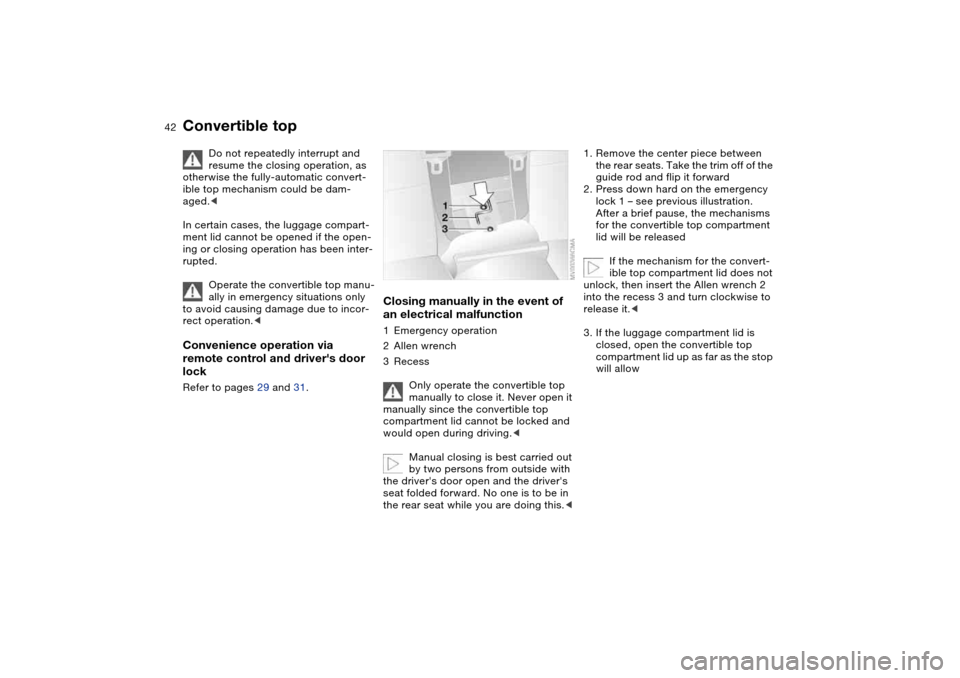
42
Do not repeatedly interrupt and
resume the closing operation, as
otherwise the fully-automatic convert-
ible top mechanism could be dam-
aged.<
In certain cases, the luggage compart-
ment lid cannot be opened if the open-
ing or closing operation has been inter-
rupted.
Operate the convertible top manu-
ally in emergency situations only
to avoid causing damage due to incor-
rect operation.<
Convenience operation via
remote control and driver's door
lockRefer to pages 29 and 31.
Closing manually in the event of
an electrical malfunction1Emergency operation
2Allen wrench
3Recess
Only operate the convertible top
manually to close it. Never open it
manually since the convertible top
compartment lid cannot be locked and
would open during driving.<
Manual closing is best carried out
by two persons from outside with
the driver's door open and the driver's
seat folded forward. No one is to be in
the rear seat while you are doing this.<
1. Remove the center piece between
the rear seats. Take the trim off of the
guide rod and flip it forward
2. Press down hard on the emergency
lock 1 – see previous illustration.
After a brief pause, the mechanisms
for the convertible top compartment
lid will be released
If the mechanism for the convert-
ible top compartment lid does not
unlock, then insert the Allen wrench 2
into the recess 3 and turn clockwise to
release it.<
3. If the luggage compartment lid is
closed, open the convertible top
compartment lid up as far as the stop
will allow
Convertible top
Page 43 of 174

43
4. Grasp the convertible top by the lat-
eral guide section – see arrow 1 –
and the front convertible top frame –
see arrow 2. Lift out the top and
swing forward until you encounter a
perceptible resistance at a stop.
Position the rear convertible top
frame vertically and close the con-
vertible top compartment lid. Fold
down the rear convertible top frame
To avoid damaging the side trim,
always fold the convertible top
forward before folding the rear frame
brace up into its vertical position.<
5. Use a screwdriver to lift out the cover
panel that is in the center of the front
convertible top frame
6. Insert the Allen wrench 2 – refer to
page 42 – into the recess – see arrow
7. Pull down on the front convertible
top frame as far as possible. Close
the convertible top further by turning
the wrench in a clockwise direction;
continue turning until the front con-
vertible top frame is locked to the
windshield frame. The rear convert-
ible top frame will automatically be
pressed down onto the convertible
top compartment lid and, because of
the tension, will close completely.
The closing operation must be
completed, as otherwise damage
and/or injuries may result.<
Please consult your BMW center
to have the defect corrected.<
Convertible top
OverviewControlsMaintenanceRepairsDataIndex
Page 82 of 174
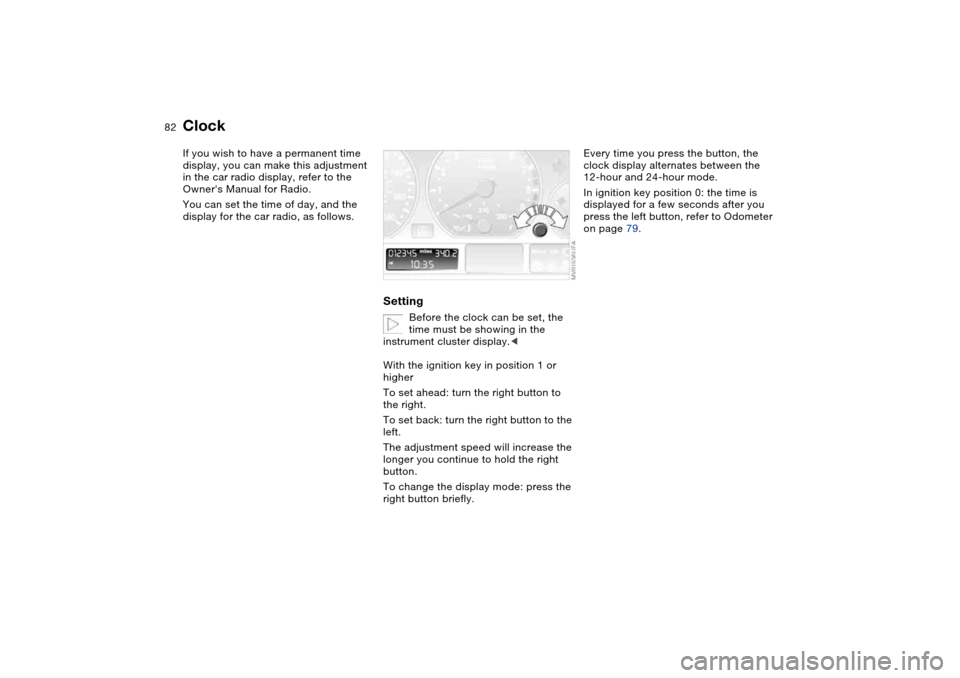
82
ClockIf you wish to have a permanent time
display, you can make this adjustment
in the car radio display, refer to the
Owner's Manual for Radio.
You can set the time of day, and the
display for the car radio, as follows.
Setting
Before the clock can be set, the
time must be showing in the
instrument cluster display.<
With the ignition key in position 1 or
higher
To set ahead: turn the right button to
the right.
To set back: turn the right button to the
left.
The adjustment speed will increase the
longer you continue to hold the right
button.
To change the display mode: press the
right button briefly.
Every time you press the button, the
clock display alternates between the
12-hour and 24-hour mode.
In ignition key position 0: the time is
displayed for a few seconds after you
press the left button, refer to Odometer
on page 79.
Page 83 of 174
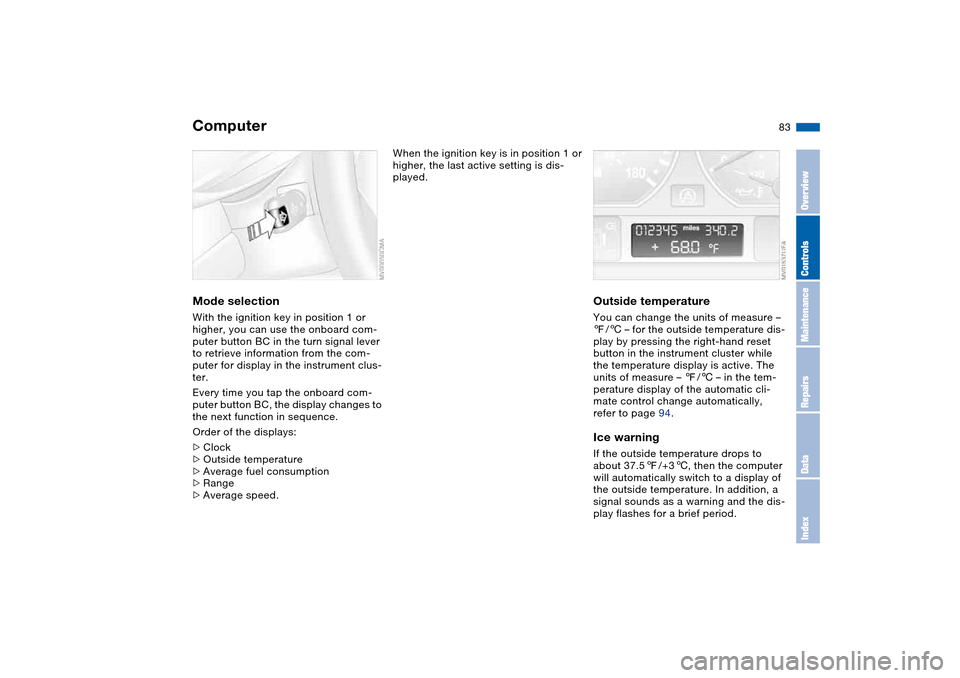
83
ComputerMode selectionWith the ignition key in position 1 or
higher, you can use the onboard com-
puter button BC in the turn signal lever
to retrieve information from the com-
puter for display in the instrument clus-
ter.
Every time you tap the onboard com-
puter button BC, the display changes to
the next function in sequence.
Order of the displays:
>Clock
>Outside temperature
>Average fuel consumption
>Range
>Average speed.
When the ignition key is in position 1 or
higher, the last active setting is dis-
played.
Outside temperatureYou can change the units of measure –
7/6 – for the outside temperature dis-
play by pressing the right-hand reset
button in the instrument cluster while
the temperature display is active. The
units of measure – 7/6 – in the tem-
perature display of the automatic cli-
mate control change automatically,
refer to page 94.Ice warningIf the outside temperature drops to
about 37.57/+36, then the computer
will automatically switch to a display of
the outside temperature. In addition, a
signal sounds as a warning and the dis-
play flashes for a brief period.
OverviewControlsMaintenanceRepairsDataIndex
Page 128 of 174

128
Low ambient temperaturesThe oils used by BMW at the factory for
your vehicle model can be used at virtu-
ally any ambient temperature.
However, if the vehicle is exposed to
temperatures below –47/–206 for
extended periods, please have your
BMW center recommend a suitable oil.
Coolant
Do not open the cooling system
when the engine is hot. If you do,
escaping coolant can cause burns.<
Coolant consists of water and coolant
additives. Not all commercially available
additives are suitable for your BMW.
Your BMW center knows which addi-
tives are appropriate.
Only use approved additives, as
the engine could otherwise be
damaged. The additives are hazardous
to health.<
Comply with the applicable envi-
ronmental laws regulating
the disposal of coolant additives.<
Checking the coolant level1. The engine must be at ambient tem-
perature
2. Open the cap for the expansion tank
by turning it slightly counterclock-
wise to allow accumulated pressure
to escape. Then open
3. The coolant level is correct when the
upper end of the red float is even
with the upper edge of the filler neck,
refer to the arrow in the illustration or
to the schematic diagram next to the
filler neck
4. If necessary, slowly add coolant until
the correct level is reached; do not
overfill
5. Close the cap by turning until it is
well tight
6. Have the cause for the coolant loss
removed as soon as possible.
Engine oil
Page 145 of 174
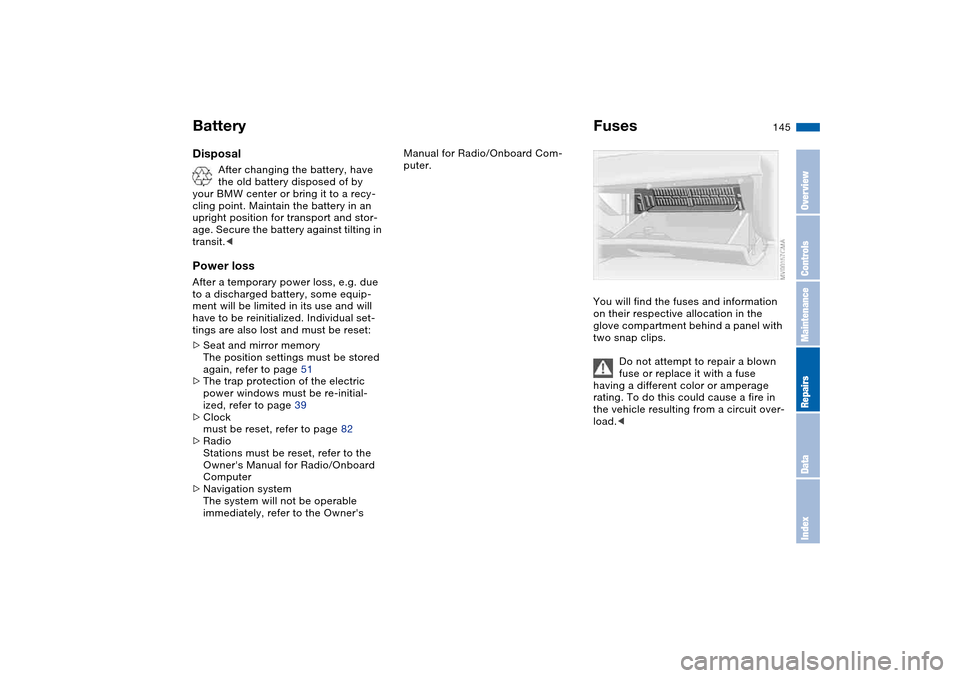
145
Disposal
After changing the battery, have
the old battery disposed of by
your BMW center or bring it to a recy-
cling point. Maintain the battery in an
upright position for transport and stor-
age. Secure the battery against tilting in
transit.<
Power lossAfter a temporary power loss, e.g. due
to a discharged battery, some equip-
ment will be limited in its use and will
have to be reinitialized. Individual set-
tings are also lost and must be reset:
>Seat and mirror memory
The position settings must be stored
again, refer to page 51
>The trap protection of the electric
power windows must be re-initial-
ized, refer to page 39
>Clock
must be reset, refer to page 82
>Radio
Stations must be reset, refer to the
Owner's Manual for Radio/Onboard
Computer
>Navigation system
The system will not be operable
immediately, refer to the Owner's
Manual for Radio/Onboard Com-
puter.
FusesYou will find the fuses and information
on their respective allocation in the
glove compartment behind a panel with
two snap clips.
Do not attempt to repair a blown
fuse or replace it with a fuse
having a different color or amperage
rating. To do this could cause a fire in
the vehicle resulting from a circuit over-
load.<
Battery
OverviewControlsMaintenanceRepairsDataIndex
Page 161 of 174
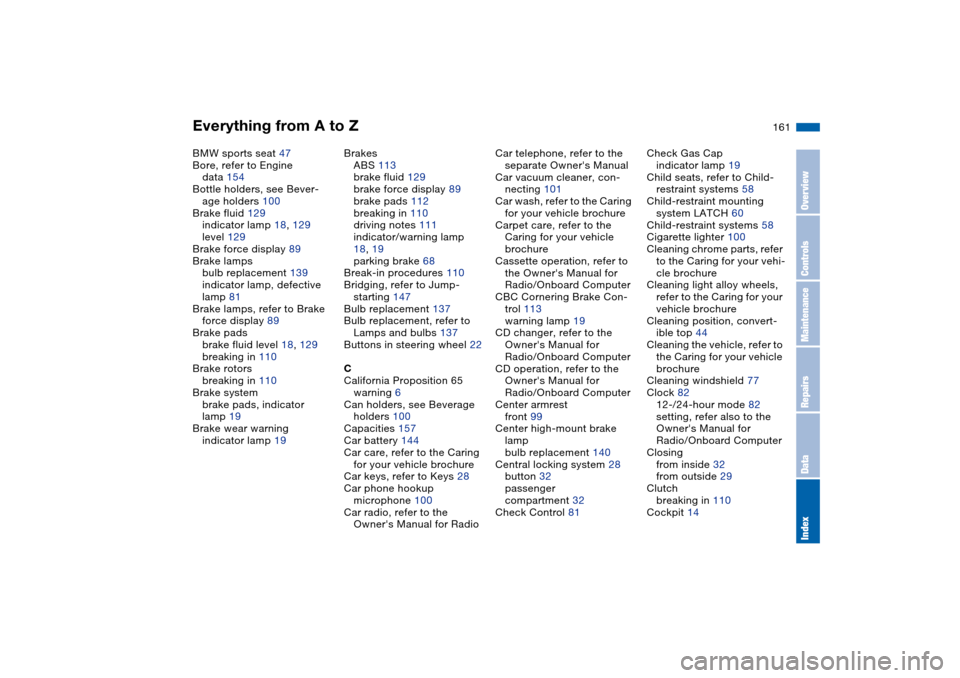
Everything from A to Z
161
BMW sports seat 47
Bore, refer to Engine
data 154
Bottle holders, see Bever-
age holders 100
Brake fluid 129
indicator lamp 18, 129
level 129
Brake force display 89
Brake lamps
bulb replacement 139
indicator lamp, defective
lamp 81
Brake lamps, refer to Brake
force display 89
Brake pads
brake fluid level 18, 129
breaking in 110
Brake rotors
breaking in 110
Brake system
brake pads, indicator
lamp 19
Brake wear warning
indicator lamp 19Brakes
ABS 113
brake fluid 129
brake force display 89
brake pads 112
breaking in 110
driving notes 111
indicator/warning lamp
18, 19
parking brake 68
Break-in procedures 110
Bridging, refer to Jump-
starting 147
Bulb replacement 137
Bulb replacement, refer to
Lamps and bulbs 137
Buttons in steering wheel 22
C
California Proposition 65
warning 6
Can holders, see Beverage
holders 100
Capacities 157
Car battery 144
Car care, refer to the Caring
for your vehicle brochure
Car keys, refer to Keys 28
Car phone hookup
microphone 100
Car radio, refer to the
Owner's Manual for RadioCar telephone, refer to the
separate Owner's Manual
Car vacuum cleaner, con-
necting 101
Car wash, refer to the Caring
for your vehicle brochure
Carpet care, refer to the
Caring for your vehicle
brochure
Cassette operation, refer to
the Owner's Manual for
Radio/Onboard Computer
CBC Cornering Brake Con-
trol 113
warning lamp 19
CD changer, refer to the
Owner's Manual for
Radio/Onboard Computer
CD operation, refer to the
Owner's Manual for
Radio/Onboard Computer
Center armrest
front 99
Center high-mount brake
lamp
bulb replacement 140
Central locking system 28
button 32
passenger
compartment 32
Check Control 81Check Gas Cap
indicator lamp 19
Child seats, refer to Child-
restraint systems 58
Child-restraint mounting
system LATCH 60
Child-restraint systems 58
Cigarette lighter 100
Cleaning chrome parts, refer
to the Caring for your vehi-
cle brochure
Cleaning light alloy wheels,
refer to the Caring for your
vehicle brochure
Cleaning position, convert-
ible top 44
Cleaning the vehicle, refer to
the Caring for your vehicle
brochure
Cleaning windshield 77
Clock 82
12-/24-hour mode 82
setting, refer also to the
Owner's Manual for
Radio/Onboard Computer
Closing
from inside 32
from outside 29
Clutch
breaking in 110
Cockpit 14
OverviewControlsMaintenanceRepairsDataIndex
Page 162 of 174
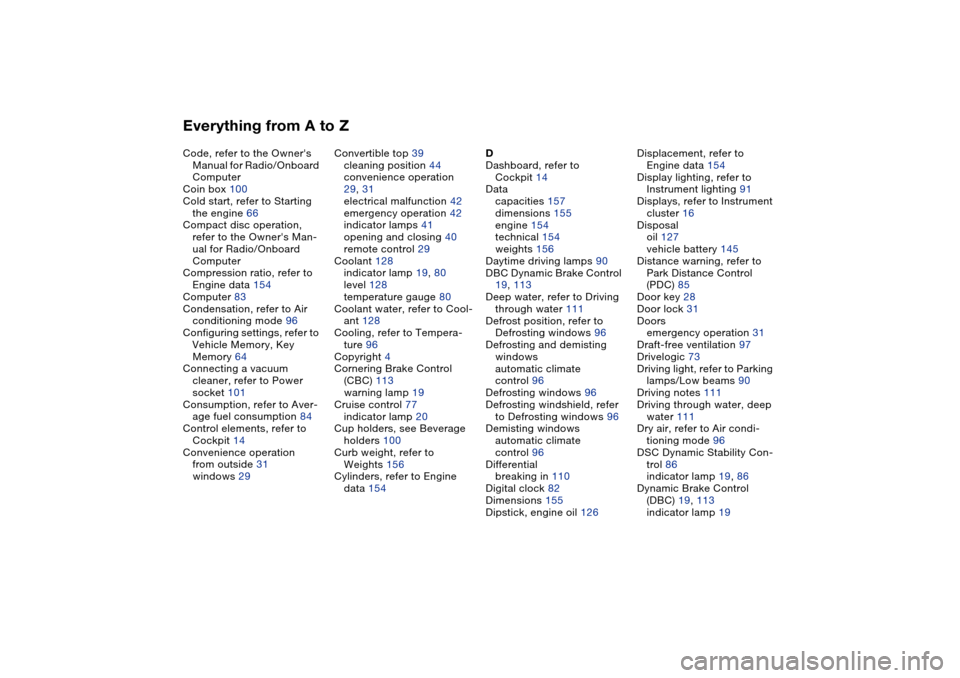
Everything from A to ZCode, refer to the Owner's
Manual for Radio/Onboard
Computer
Coin box 100
Cold start, refer to Starting
the engine 66
Compact disc operation,
refer to the Owner's Man-
ual for Radio/Onboard
Computer
Compression ratio, refer to
Engine data 154
Computer 83
Condensation, refer to Air
conditioning mode 96
Configuring settings, refer to
Vehicle Memory, Key
Memory 64
Connecting a vacuum
cleaner, refer to Power
socket 101
Consumption, refer to Aver-
age fuel consumption 84
Control elements, refer to
Cockpit 14
Convenience operation
from outside 31
windows 29Convertible top 39
cleaning position 44
convenience operation
29, 31
electrical malfunction 42
emergency operation 42
indicator lamps 41
opening and closing 40
remote control 29
Coolant 128
indicator lamp 19, 80
level 128
temperature gauge 80
Coolant water, refer to Cool-
ant 128
Cooling, refer to Tempera-
ture 96
Copyright 4
Cornering Brake Control
(CBC) 113
warning lamp 19
Cruise control 77
indicator lamp 20
Cup holders, see Beverage
holders 100
Curb weight, refer to
Weights 156
Cylinders, refer to Engine
data 154D
Dashboard, refer to
Cockpit 14
Data
capacities 157
dimensions 155
engine 154
technical 154
weights 156
Daytime driving lamps 90
DBC Dynamic Brake Control
19, 113
Deep water, refer to Driving
through water 111
Defrost position, refer to
Defrosting windows 96
Defrosting and demisting
windows
automatic climate
control 96
Defrosting windows 96
Defrosting windshield, refer
to Defrosting windows 96
Demisting windows
automatic climate
control 96
Differential
breaking in 110
Digital clock 82
Dimensions 155
Dipstick, engine oil 126Displacement, refer to
Engine data 154
Display lighting, refer to
Instrument lighting 91
Displays, refer to Instrument
cluster 16
Disposal
oil 127
vehicle battery 145
Distance warning, refer to
Park Distance Control
(PDC) 85
Door key 28
Door lock 31
Doors
emergency operation 31
Draft-free ventilation 97
Drivelogic 73
Driving light, refer to Parking
lamps/Low beams 90
Driving notes 111
Driving through water, deep
water 111
Dry air, refer to Air condi-
tioning mode 96
DSC Dynamic Stability Con-
trol 86
indicator lamp 19, 86
Dynamic Brake Control
(DBC) 19, 113
indicator lamp 19